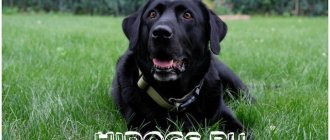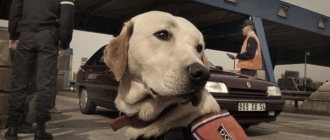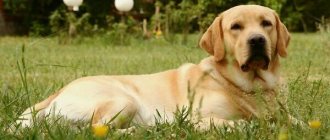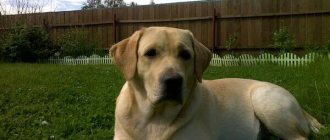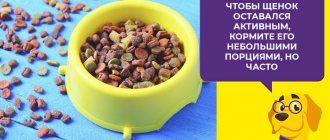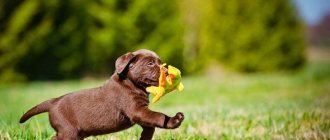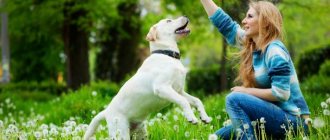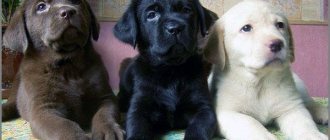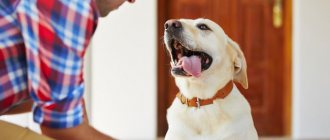- FCI № 122 29.01.1999
- ORIGIN. Great Britain.
- APPLICATION. Gun dog.
- FCI CLASSIFICATION. Group 8 - retrievers, spaniels, water dogs.
- Section 1. Retrievers. With working tests.
1. Forehead 2. Transition from forehead to muzzle 3. Muzzle 4. Nose 5. Ears 6. Nuchal protuberance 7. Cheekbones 8. Eyes 9. Neck 10. Withers 11. Back 12. Loin 13. Croup 14. Fore chest 15. Side chest 16. Lower chest
17. Belly 18. Groin 19. Shoulders 20. Elbows 21. Forearms 22. Wrists 23. Pasterns 24. Forepaws 25. Hips 26. Knees 27. Shins 28. Hocks 29. Hocks 30. Hind legs 31. Tail
General impression.
Strongly built, compact, very active with a voluminous head in the skull, a wide and deep chest and ribs, wide and strong hind legs and loin.
Behavior and temperament
. Good temperament. Agile and dexterous. Excellent instinct, soft grip when serving game, loves water very much. Easily adaptable, loyal companion. Intelligent, insightful and obedient, with a strong desire to please his master. Good-natured and affectionate, without a hint of aggression or timidity.
Head.
Cranial section. The skull is wide, clean lines, without fleshy cheeks. The transition from forehead to muzzle is pronounced. Facial section. The nose is wide, with well-developed nostrils. The muzzle is powerful and not pointed. Jaws. Medium sized teeth. The jaws are strong with an excellent even, regular scissor bite. The upper incisors tightly cover the lower ones. The teeth stand vertically in the jaw. Eyes. Medium size, with an intelligent and friendly expression. Brown or nutty. Ears. Not wide, not heavy, hanging, close to the head, set far back.
Neck.
Clean lines, strong, powerful, well placed on the shoulders.
Frame.
The back is a straight top line. The loin is wide, short and strong. Chest of good depth and length, with well arched ribs.
Tail.
A distinctive feature of the breed. Very thick at the base, gradually tapering towards the end, of medium length without dewlap, but covered with dense short hair, giving it the appearance of a round “otter” tail. Should not bend over onto your back.
Forelegs
. Straight, with strong bones. The shoulder is long and oblique.
Hind limbs
. Well developed, the croup is not sloping towards the tail. Knee joints with good angles. The hock joints are set low. Cow standing is highly undesirable.
Paws
. Round, compact, well arched, with developed pads.
Movements
. Free, productive. Straight and parallel fore and hind legs.
Wool
. The quality of wool is a distinctive feature. Short, thick without waves or fringes, hard and dense to the touch. Dense waterproof undercoat.
Color
. Solid black, yellow or brown. Yellow from light cream to fox red. A small white patch on the chest is acceptable.
Size
. Ideal height at the withers: males - 56-57cm, females - 54-56cm.
Flaws
. Any deviation from the above points is considered a defect.
Note
. Males should have two full-fledged, normally developed testes, completely descended into the scrotum.
Anatomical structure of Labrador
1. Skull 2. Occiput 3. Cervical vertebrae (7) 4. Thoracic vertebrae (13) 5. Lumbar vertebrae (7) 6. Sacral bone 7. Pelvis 8. Caudal vertebrae 9. Femur 10. Tibia 11. Tarsal bone 12. Metatarsal bone 13. Fibula
4. Patella 15. Ribs 16. Sternum 17. Metacarpal bones 18. Phalanges 19. Carpal bones 20. Ulna 21. Radius 22. Humerus 23. Substernum 24. Scapula 25. Lower jaw
Health and common diseases of the Labrador
A Labrador dog has both its pros and cons. One of the disadvantages is the short lifespan - on average 10-12 years. And this is due to the high propensity of these dogs to cancer. But the main disadvantages of the breed are associated exclusively with people. Unfortunately, due to their great popularity, everyone who is not too lazy has started breeding dogs. People do not properly monitor the nutrition of future parents, dogs do not receive proper care, so choosing a puppy on a spontaneous market is categorically not recommended.
Related article: How long do Labradors live at home?
The most common diseases are listed below (remember that there are not many of them, but the risk of disease is high):
- hip dysplasia;
- retinal atrophy;
- atopic dermatitis;
- epilepsy.
COMPARISON AND ANALYSIS OF BRITISH AND AMERICAN STANDARDS
The British Labrador Retriever Breed Standard has become the source for other standards, as Britain is considered the breed's country of origin. The FCI considers Labradors to be a British breed and uses the current British Kennel Club Breed Standards in the 1986 version.
AMERICAN BREED STANDARD
The American Kennel Club was founded in 1884, and Labradors were first recognized as an independent breed in the late 1920s. Previously, they were classified as retrievers along with other varieties. At first, the American Standards were fully consistent with the British, but after changes were made, differences appeared between the two standards. Both standards were revised in the 1950s. The official American Kennel Club Standard was adopted on April 9, 1957 and contained many differences from the British one. It included: Head. Weakly defined bridge of the nose (for comparison, the pronounced bridge of the nose in the British standard). Long jaws (cf. medium-long jaws). Mouth. The incisors are at the same level (the lower incisors are slightly behind, but are in close contact with the upper ones). Eyes. Brown yellow or black, but preferably brown or black (cf. brown or sand). Wool. Short, thick coat without curling and creates a feeling of hardness to the touch (cf. short thick coat without curling with an undercoat that protects the dog from bad weather and hard to the touch). Weight. Males - 27-34 kg, females - 25-32 kg (cf. British Standard). Height. Males - 57-62 cm, females - 54-59 cm (cf. males - 55-57 cm, females - 54-55 cm). Flaws. None. (cf. undershot and undershot, lack of undercoat, lack of activity, feathering, dents on the head, large and heavy ears, “cow legs”, tail curled over the back). However, during the 1990s, many controversial revisions occurred in the United States, culminating in the adoption of the final Standard on March 31, 1994. It is opposed by the majority of judges and breeders who believe that it is too long and verbose, but the main reason for its rejection is that it contains disqualifying characteristics.
GENERAL IMPRESSION
British Standard. The Labrador should give the impression of a strongly built, compact, very active dog, with a voluminous head in the skull, a wide and deep chest, a wide and strong loin and croup.
American Standard. The Labrador Retriever is a strongly built, compact, medium-sized dog with a strong, athletic and well-balanced build that allows it to function as a hunting dog in retrieving and retrieving prey. The robust build is essential for long hours of hunting waterfowl and land game in difficult conditions. Her character and qualities help her win in the show ring, and her temperament makes her a family companion. The physical and mental qualities must be those of a dog bred to perform efficient work of retrieving and retrieving prey, and the stable temperament is suitable for a wide variety of tasks other than hunting. The most distinctive characteristics of the Labrador Retriever are a short, dense and weather-resistant coat, an otter tail, a clean-lined head with a wide skull and a moderate bridge of the nose, powerful jaws, a friendly look that reflects the character of the mind. Above all, the Labrador must be well balanced to move gracefully around the show ring and perform well in the field with a minimum of effort. The typical Labrador has style and quality without being too subtle, and strength of structure without being clumsy or ponderous. The Labrador was created primarily as a working hunting dog, so the structure and strength of the body are of great importance.
At first glance we see how verbose the American part is and how many repetitions there are in it. But if you shorten it, it is better than its British equivalent for the following reasons: The balance of movements in the British version is missing; attention is paid to the hunting and tracking functions of the breed, which, surprisingly, is not in the British Standard; The classic hallmarks of the breed - its coat, otter tail, head and expression - are further explained in detail. This also refers to the need for a strong physique without clumsiness or heaviness. Surely these points will withstand any revisions.
Character and training
According to the standard and reviews from experienced owners, the Labrador Retriever falls under a positive description. Since the breed does not have an aggression gene, it is recommended that the dog be adopted by large families, where it will get along well with children. This breed has a very soft character, it will make friends with any other animal, and will even treat a dog kindly. He will never show cockiness, at most he will bite a little in his defense.
The Labrador, like any retriever, has a docile nature. Even a child aged 10–12 years can easily raise and train him. He easily learns all types of commands and tricks. The Labrador is inferior in speed to other hunting dogs, but there is no need to be upset, agility is its main advantage.
We recommend this article:
Rules for raising and training a Labrador from the first days
Training can be done at home, but for this the owner will need professional literature describing the breed and patience. It is better for a novice dog breeder to contact a trainer. This breed of dog serves people as a guide; in such cases, the Labrador Retriever undergoes boarding training.
Related article: Can a Labrador live in an outdoor enclosure in winter?
Why is the bite deformed?
Correcting overbite in dogs in adulthood is almost impossible, so it is necessary to direct all efforts to prevent this problem from occurring in the puppy in the first place. Let's find out what causes a dog's malocclusion.
Genetics
In most cases, misalignment of teeth is caused by hereditary reasons. Let us note that an incorrect bite not only leads to digestive problems, but is also a defect that affects the dog’s show characteristics, destroying the reproductive meaning of a given specimen. A purebred dog with an incorrect bite is, as a rule, not allowed to further breed in order to avoid the formation of the same defect in the offspring.
All breeders know how important it is to control correct bites. Culling of animals with malocclusion occurs from a very early age, and only flawless individuals who do not have ancestors with similar defects in their family are allowed to breed.
Metabolic pathologies
Some types of diseases, especially at a young age, lead to this problem. Most often, malocclusion is caused by rickets.
Nutritional deficiencies
If a puppy systematically does not receive the minerals and vitamins it needs, this fact has a negative impact on the condition of the entire body. In addition to malocclusion, a puppy can develop much more serious pathologies for this reason. Minerals such as calcium and vitamin D3 are of particular importance for a growing dog’s body.
If the bitch's diet during pregnancy did not contain enough trace elements, vitamins and calcium, the birth of puppies with malocclusion is much more likely.
Baby teeth
If the change of baby teeth occurs untimely in a puppy: later or ahead of schedule, an incorrect bite may well form. For this reason, a dog can develop both overbite and underbite teeth. In addition, molars often grow crooked due to the fact that they are forced to rest against the milk teeth that have not yet fallen out. To eliminate this cause of malocclusion, you should contact a veterinarian to remove the puppy’s baby teeth when the molars have already begun to grow.
Injuries
Sometimes dogs can injure their jaws while playing, fighting, or chewing hard objects. It must be borne in mind that regular chewing by a dog of hard bones, pieces of wood and other objects in most cases leads to crooked dentition.
Puppies love games with dividing objects, however, serious stress on the jaws and teeth during these games may well lead to the curvature of a number of teeth. The owner of the animal should clearly understand: you can play with the dog, but trying with all your might to pull the toy out of his mouth is not. Often, owners of dogs of fighting breeds, wanting to develop the jaws of their pets as strongly as possible, encourage the animal to carry bricks in its teeth, hang with its jaws closed on sticks, etc. Of course, it is for fighting breeds that a misalignment of the bite is acceptable, but sometimes this defect can be too obvious.
You should not hit the dog: if the blow lands on the jaw or nose, this can lead to both the formation of an incorrect bite and serious disorders of the nasopharynx and pathologies of the chewing joints. In case of serious injuries, sometimes even a veterinarian cannot help the animal.
Disadvantages of parenting
If you do not train your dog, the animal may begin to chew on everything: the dog, without encountering dissatisfaction from the owner, gnaws furniture legs, door frames, stones and other hard objects not intended for teeth. As a result, the animal often develops an incorrect bite, teeth and gums are injured.
Incorrect bite — Page 2 — Raising puppies — Labrador.ru dogs
Incorrect bite — Page 2 — Raising puppies — Labrador.ru dogs — retrieversJump to content
White Angel 199
- Forum resident
- Users.
- 199
- 2,537 posts
- Sex:Female
- City:Minsk
Natik 3,782
- Forum resident
- Users.
- 3,782
- 2,923 posts
- Sex:Female
- City:Odintsovo district
Deniska 19,297
- Aksakal
- Users.
- 19,297
- 29,261 posts
- Sex:Female
- City:Moscow, Begovaya metro station, Alexandrov, Vladimir region
Venc 307
- Companion
- Users.
- 307
- 605 posts
- Sex:Male
- City:Moscow, Lubyanka
Deniska 19,297
- Aksakal
- Users.
- 19,297
- 29,261 posts
- Sex:Female
- City:Moscow, Begovaya metro station, Alexandrov, Vladimir region
Venc 307
- Companion
- Users.
- 307
- 605 posts
- Sex:Male
- City:Moscow, Lubyanka
barberry 3,099
- Aksakal
- Users.
- 3,099
- 10,733 posts
- Sex:Female
- City:Moscow
Natik 3,782
- Forum resident
- Users.
- 3,782
- 2,923 posts
- Sex:Female
- City:Odintsovo district
Deniska 19,297
- Aksakal
- Users.
- 19,297
- 29,261 posts
- Sex:Female
- City:Moscow, Begovaya metro station, Alexandrov, Vladimir region
Natik 3,782
- Forum resident
- Users.
- 3,782
- 2,923 posts
- Sex:Female
- City:Odintsovo district
ICQ and Dogs 6,570
- Aksakal
- Users.
- 6,570
- 8,398 posts
- Sex:Female
- City:Moscow, VAO, Preobrazhenka
ElenaK 648
- Forum resident
- Users.
- 648
- 2,444 posts
- Trainer
- Sex:Female
- City:Moscow
White Angel 199
- Forum resident
- Users.
- 199
- 2,537 posts
- Sex:Female
- City:Minsk
White Angel 199
- Forum resident
- Users.
- 199
- 2,537 posts
- Sex:Female
- City:Minsk
Haibon 1,043
- Active participant
- Users.
- 1,043
- 1,705 posts
- Sex:Female
- Region:Altai Territory
- City:Barnaul
White Angel 199
- Forum resident
- Users.
- 199
- 2,537 posts
- Sex:Female
- City:Minsk
labrador.ru
Missing teeth. Need some advice. — Pedigree breeding — Labrador.ru dogs
Archived
This topic is now archived and is closed to further replies.
Sabbakka 0
- Newbie
- Users.
- 0
- 4 posts
- Region:Kamchatka region
- City:Petropavlovsk-Kamchatsky
Karol Rut 98
- Companion
- Users.
- 98
- 449 posts
- Sex:Female
- City:Moscow
Sabbakka 0
- Newbie
- Users.
- 0
- 4 posts
- Region:Kamchatka region
- City:Petropavlovsk-Kamchatsky
Aqua 137
- Aksakal
- Users.
- 137
- 4,151 posts
- Sex:Female
- City: Moscow
ElenaK 648
- Forum resident
- Users.
- 648
- 2,444 posts
- Trainer
- Sex:Female
- City:Moscow
Sabbakka 0
- Newbie
- Users.
- 0
- 4 posts
- Region:Kamchatka region
- City:Petropavlovsk-Kamchatsky
Sabbakka 0
- Newbie
- Users.
- 0
- 4 posts
- Region:Kamchatka region
- City:Petropavlovsk-Kamchatsky
fermoza 4,213
- Forum resident
- Users.
- 4,213
- 2,547 posts
- Sex:Female
- City:Peter
ksu & Ko 45
- Active participant
- Users.
- 45
- 1,052 posts
- Vet
- Sex:Female
- City:Moscow, Vykhino
Lena Ulya Asya Mona 12,475
- Aksakal
- Users.
- 12,475
- 10,008 posts
- Sex:Female
- Region:Kaliningrad region
- City: Kaliningrad
Yana Avdyushina 902
- Active participant
- Users.
- 902
- 1,581 posts
- Dog handler, handler
- Sex:Female
- City:Moscow
ElenaK 648
- Forum resident
- Users.
- 648
- 2,444 posts
- Trainer
- Sex:Female
- City:Moscow
Stepan and Plusha 4
- Participant
- Users.
- 4
- 59 posts
- Sex:Male
- City:Moscow
fermoza 4,213
- Forum resident
- Users.
- 4,213
- 2,547 posts
- Sex:Female
- City:Peter
Stepan and Plusha 4
- Participant
- Users.
- 4
- 59 posts
- Sex:Male
- City:Moscow
Ukhtyshka 252
- Forum resident
- Users.
- 252
- 3,993 posts
- Sex:Female
labrador.ru
Change of teeth, bite. — Flat-haired retrievers — Labrador.ru dogs
Change of teeth, bite. — Flat-haired retrievers — Labrador.ru dogs — retrieversJump to content
Katya1982 2
- Newbie
- Users.
- 2
- 14 posts
- Sex:Female
- City:Tyumen
Lady_Juli 9,788
- Aksakal
- Users.
- 9,788
- 6,773 posts
- Sex:Female
- Region:Kaluga region
- City:Kaluga
Katya1982 2
- Newbie
- Users.
- 2
- 14 posts
- Sex:Female
- City:Tyumen
Lady_Juli 9,788
- Aksakal
- Users.
- 9,788
- 6,773 posts
- Sex:Female
- Region:Kaluga region
- City:Kaluga
Katya1982 2
- Newbie
- Users.
- 2
- 14 posts
- Sex:Female
- City:Tyumen
Lady_Juli 9,788
- Aksakal
- Users.
- 9,788
- 6,773 posts
- Sex:Female
- Region:Kaluga region
- City:Kaluga
Anna and beloved Bond 16,162
- Aksakal
- Users.
- 16,162
- 10,650 posts
- Sex:Female
- Region:MO
- City:Dedovsk
Katya1982 2
- Newbie
- Users.
- 2
- 14 posts
- Sex:Female
- City:Tyumen
Katya1982 2
- Newbie
- Users.
- 2
- 14 posts
- Sex:Female
- City:Tyumen
Katya1982 2
- Newbie
- Users.
- 2
- 14 posts
- Sex:Female
- City:Tyumen
Anna and beloved Bond 16,162
- Aksakal
- Users.
- 16,162
- 10,650 posts
- Sex:Female
- Region:MO
- City:Dedovsk
Christina - ingra 325
- Companion
- Users.
- 325
- 284 posts
- Sex:Female
- City:Tula
Katya1982 2
- Newbie
- Users.
- 2
- 14 posts
- Sex:Female
- City:Tyumen
Christina - ingra 325
- Companion
- Users.
- 325
- 284 posts
- Sex:Female
- City:Tula
Katya1982 2
- Newbie
- Users.
- 2
- 14 posts
- Sex:Female
- City:Tyumen
Lady_Juli 9,788
- Aksakal
- Users.
- 9,788
- 6,773 posts
- Sex:Female
- Region:Kaluga region
- City:Kaluga
Lady_Juli 9,788
- Aksakal
- Users.
- 9,788
- 6,773 posts
- Sex:Female
- Region:Kaluga region
- City:Kaluga
Katya1982 2
- Newbie
- Users.
- 2
- 14 posts
- Sex:Female
- City:Tyumen
Shaman 13,125
- Aksakal
- Users.
- 13,125
- 10,353 posts
- Sex:Male
- City:Nerezinovsk, Preobrazhenka
Katya1982 2
- Newbie
- Users.
- 2
- 14 posts
- Sex:Female
- City:Tyumen
labrador.ru

